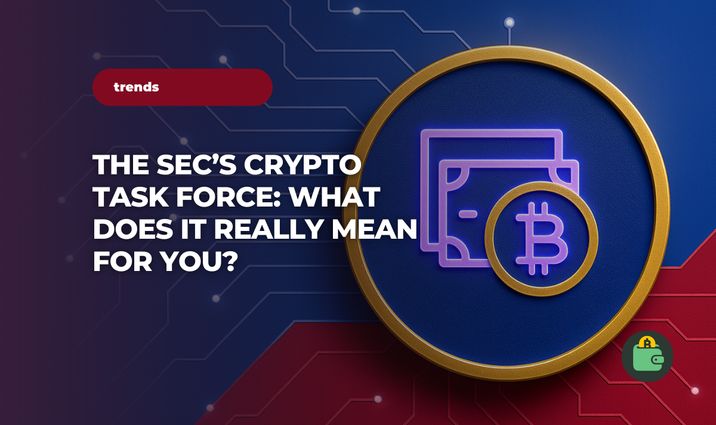The SEC’s Crypto Task Force: What Does It Really Mean for You?

In early 2025, an event occurred in the U.S. that could radically change regulators’ attitude toward the cryptocurrency industry. The U.S. Securities and Exchange Commission (SEC) announced the creation of a special task force on crypto assets — the Crypto Task Force. For many market participants, this signaled the beginning of a more balanced approach to crypto regulation. In this article, we examine how this agency operates and what it means for the market.
What is the SEC?
The SEC is an independent federal agency responsible for overseeing the securities market. It regulates the issuance and trading of stocks, bonds, investment funds, and other financial instruments. The commission’s mission is to protect investors, maintain market transparency and efficiency, and promote capital formation.
The SEC is headed by a board of five commissioners appointed by the president, with no more than three members from the same party allowed by law. The commission has broad powers, ranging from developing rules to bringing legal action against violators.
If necessary, the SEC refers cases to the Department of Justice for criminal prosecution.
How Does the SEC Regulate Crypto?
Since the emergence of cryptocurrencies, regulators have faced a dilemma: whether to consider digital tokens as securities and apply existing legislation to them. Many tokens, especially those issued as part of ICOs or investment schemes, have indeed fallen under the definition of securities.
In previous years, the SEC often acted after the fact, bringing cases against crypto projects for working with unregistered securities. This approach became known in the industry as “regulation by enforcement” and created an atmosphere of uncertainty. Companies feared that their tokens could be deemed illegal at any moment and that their activities could be subject to litigation. This discouraged innovative projects and, in some cases, forced them to leave the U.S.
The situation began to change in 2025, when new leadership came to the SEC. The previous hard line was replaced by a course of dialogue and the formation of clear rules. The Crypto Task Force, headed by Commissioner Hester Peirce, was given a mandate to develop a comprehensive regulatory framework for crypto assets.
For the first time, the SEC openly acknowledged that its previous practice, based mainly on legal action, had created unnecessary legal uncertainty and had hindered the development of technology. The task now is to define the boundaries of regulation, propose realistic mechanisms for registration and disclosure of information, and focus on truly malicious violators.
Project Crypto by the SEC
In parallel with the work of the task force, the SEC launched a large-scale initiative called “Project Crypto.” Its goal is to adapt financial regulation to the realities of the blockchain economy.
Commission Chairman Paul Atkins has stated outright that U.S. markets must go “on-chain,” and the regulator is obliged to facilitate this. The project includes the development of clear criteria for token classification, the creation of “safe havens” for the issuance and distribution of digital assets, and the simplification of the tokenization of traditional securities with the possibility of trading them on decentralized platforms.
The SEC is also considering reforming regulations so that licensed platforms can operate with both securities and cryptocurrencies, providing users with unified access to all types of assets. Another important idea is the introduction of temporary regulatory “sandboxes” that will allow new products to be tested without immediate compliance with all requirements, provided that key investor protection principles are observed.
At the same time, the SEC has clearly stated that tokenization does not change the legal nature of an asset: a tokenized share remains a share and is therefore subject to the same laws. This warning is intended to prevent attempts to circumvent legislation under the guise of “new technology.” The commission is also ready to consider proposals to adapt the rules and grant special permits for bona fide projects.
What Does the SEC’s Activity Mean for Users and Builders?
For developers and startups, this opens up new opportunities. The risk of sudden prosecution is reduced, and there is a chance to understand in advance what rules will apply to a specific product. The range of legal business models is expanding — from asset tokenization to the integration of traditional and crypto financial services in a single application. Finally, the industry is gaining a direct channel of influence on policy formation through participation in discussions and the submission of proposals.
For regular crypto users, the SEC’s activity means increasing legal certainty. If the SEC follows through with its plans to classify tokens clearly and establish clear rules for their issuance, it will be easier for people to understand exactly what they are buying — an investment asset, a commodity, or a utility token. This will reduce the risk that tomorrow a favorite token will suddenly turn out to be an “illegal security” and disappear from exchanges.
In addition, the level of crypto safety will improve. Even with a more friendly approach, the SEC is not giving up the fight against fraud. On the contrary, the focus on targeted investigations and transparency requirements for projects should reduce the number of outright scams, and users will receive more reliable information before investing their funds.